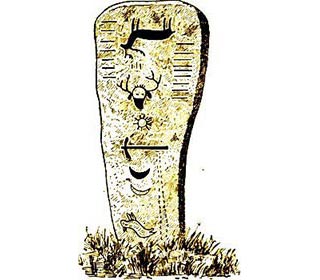The picture drawings on grave-posts consisted of symbols that represented the life of the deceased Native American Indian, his family, his deeds of courage against enemies or during hunting parties and also and wounds that were received in battle. Grave Post Symbols were not a complete record of the life of the deceased and often only used as a memory aid to those who knew his story and understood the meanings of the symbols that had been used. Grave Post Symbols are a form of picture writing, or Pictogram, which uses symbols to tell a story. The grave post symbols bore pictures or marks telling about the dead man. His totem animal was often represented, usually upside down to indicate that the bearer of the emblem was dead. Grave Post Symbols - Pictograms
Pictograms convey ideas and meanings in basic pictures of visible objects on various forms such as on their war paint, weapons, the bark of trees and the skins of animals which they made into their clothes and tepees. They were also used on Native American grave posts and in ledger books. Interpretation and Example of Grave Post Symbols
The picture signs used on the above example of the American Grave Post uses elemental, basic and logical symbols to provide the means to convey a story and ideas without writing. The example of the grave post commemorates the life of Wabojeeg, or White Fisher, a famous Ojibwa (Chippewa) war chief. He belonged to the Caribou clan, or the family, of the Addik, or American Reindeer which was his totem. The interpretation of symbols on his grave post are as follows: - At the top of the grave post is the symbol of the reindeer representing the family clan name. Note that the reindeer is depicted upside down. Any Native American symbols that were portrayed upside down or reversed signified that they had died or been killed
- The seven sloping marks on the left denote that he had led seven war-parties
- The three vertical lines below the totem represent three wounds received in battle
- The figure picturing the head of a moose denotes a mighty conflict he had experienced with this type of animal
- The symbols of the arrow and pipe indicate his influence in war and peace
|
